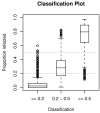Rapid assessment of Schistosoma mansoni: the validity, applicability and cost-effectiveness of the Lot Quality Assurance Sampling method in Uganda
- PMID: 15960703
- PMCID: PMC1975759
- DOI: 10.1111/j.1365-3156.2005.01446.x
Rapid assessment of Schistosoma mansoni: the validity, applicability and cost-effectiveness of the Lot Quality Assurance Sampling method in Uganda
Abstract
Rapid and accurate identification of communities at highest risk of morbidity from schistosomiasis is key for sustainable control. Although school questionnaires can effectively and inexpensively identify communities with a high prevalence of Schistosoma haematobium, parasitological screening remains the preferred option for S. mansoni. To help reduce screening costs, we investigated the validity of Lot Quality Assurance Sampling (LQAS) in classifying schools according to categories of S. mansoni prevalence in Uganda, and explored its applicability and cost-effectiveness. First, we evaluated several sampling plans using computer simulation and then field tested one sampling plan in 34 schools in Uganda. Finally, cost-effectiveness of different screening and control strategies (including mass treatment without prior screening) was determined, and sensitivity analysis undertaken to assess the effect of infection levels and treatment costs. In identifying schools with prevalences > or =50%, computer simulations showed that LQAS had high levels of sensitivity and specificity (>90%) at sample sizes <20. The method also provides an ability to classify communities into three prevalence categories. Field testing showed that LQAS where 15 children were sampled had excellent diagnostic performance (sensitivity: 100%, specificity: 96.4%, positive predictive value: 85.7% and negative predictive value: 92.3%). Screening using LQAS was more cost-effective than mass treating all schools (US$218 vs. US$482/high prevalence school treated). Threshold analysis indicated that parasitological screening and mass treatment would become equivalent for settings where prevalence > or =50% in 75% of schools and for treatment costs of US$0.19 per schoolchild. We conclude that, in Uganda, LQAS provides a rapid, valid and cost-effective method for guiding decision makers in allocating finite resources for the control of schistosomiasis.
Figures




Similar articles
-
Lot quality assurance sampling for screening communities hyperendemic for Schistosoma mansoni.Trop Med Int Health. 2003 Apr;8(4):322-8. doi: 10.1046/j.1365-3156.2003.01019.x. Trop Med Int Health. 2003. PMID: 12667151
-
Multiple category-lot quality assurance sampling: a new classification system with application to schistosomiasis control.PLoS Negl Trop Dis. 2012;6(9):e1806. doi: 10.1371/journal.pntd.0001806. Epub 2012 Sep 6. PLoS Negl Trop Dis. 2012. PMID: 22970333 Free PMC article.
-
[Identification of communities endemic for urinary bilharziosis by the "Lot Quality Assurance Sampling" method in Madagascar].Arch Inst Pasteur Madagascar. 2001;67(1-2):41-5. Arch Inst Pasteur Madagascar. 2001. PMID: 12471747 French.
-
A comparative analysis of the cost-effectiveness of treatment based on parasitological and symptomatic screening for Schistosoma mansoni in Burundi.Trop Med Int Health. 2000 Mar;5(3):192-202. doi: 10.1046/j.1365-3156.2000.00530.x. Trop Med Int Health. 2000. PMID: 10747282
-
Integration of control of schistosomiasis due to S. mansoni within primary health care in Ngamiland, Botswana.Trop Med Parasitol. 1989 Jun;40(2):195-200. Trop Med Parasitol. 1989. PMID: 2505382 Review.
Cited by
-
Neglected tropical diseases in Uganda: the prospect and challenge of integrated control.Trends Parasitol. 2007 Oct;23(10):485-93. doi: 10.1016/j.pt.2007.08.007. Epub 2007 Sep 7. Trends Parasitol. 2007. PMID: 17826335 Free PMC article. Review.
-
Combined spatial prediction of schistosomiasis and soil-transmitted helminthiasis in Sierra Leone: a tool for integrated disease control.PLoS Negl Trop Dis. 2012;6(6):e1694. doi: 10.1371/journal.pntd.0001694. Epub 2012 Jun 19. PLoS Negl Trop Dis. 2012. PMID: 22724034 Free PMC article.
-
Projecting the long-term impact of school- or community-based mass-treatment interventions for control of Schistosoma infection.PLoS Negl Trop Dis. 2012;6(11):e1903. doi: 10.1371/journal.pntd.0001903. Epub 2012 Nov 15. PLoS Negl Trop Dis. 2012. PMID: 23166850 Free PMC article.
-
Global epidemiology, ecology and control of soil-transmitted helminth infections.Adv Parasitol. 2006;62:221-61. doi: 10.1016/S0065-308X(05)62007-6. Adv Parasitol. 2006. PMID: 16647972 Free PMC article. Review.
-
Rapid mapping of schistosomiasis and other neglected tropical diseases in the context of integrated control programmes in Africa.Parasitology. 2009 Nov;136(13):1707-18. doi: 10.1017/S0031182009005940. Epub 2009 May 19. Parasitology. 2009. PMID: 19450373 Free PMC article. Review.
References
-
- Ansell J, Guyatt HL. Comparative cost-effectiveness of diagnostic tests for urinary schistosomiasis and the implication for school health programmes. Annals of Tropical Medicine and Parasitology. 2002;96:145–153. - PubMed
-
- Bennett S, Woods S, Liyanage WM, Smith DL. A simplified general method for cluster-sample surveys of health in developing countries. World Health Statistics Quarterly. 1991;44:98–106. - PubMed
-
- Brooker S, Miguel EA, Moulin S, et al. The potential of rapid screening methods for Schistosoma mansoni in Western Kenya. Annals of Tropical Medicine and Parasitology. 2001b;95:343–351. - PubMed
Publication types
MeSH terms
Grants and funding
LinkOut - more resources
Full Text Sources

